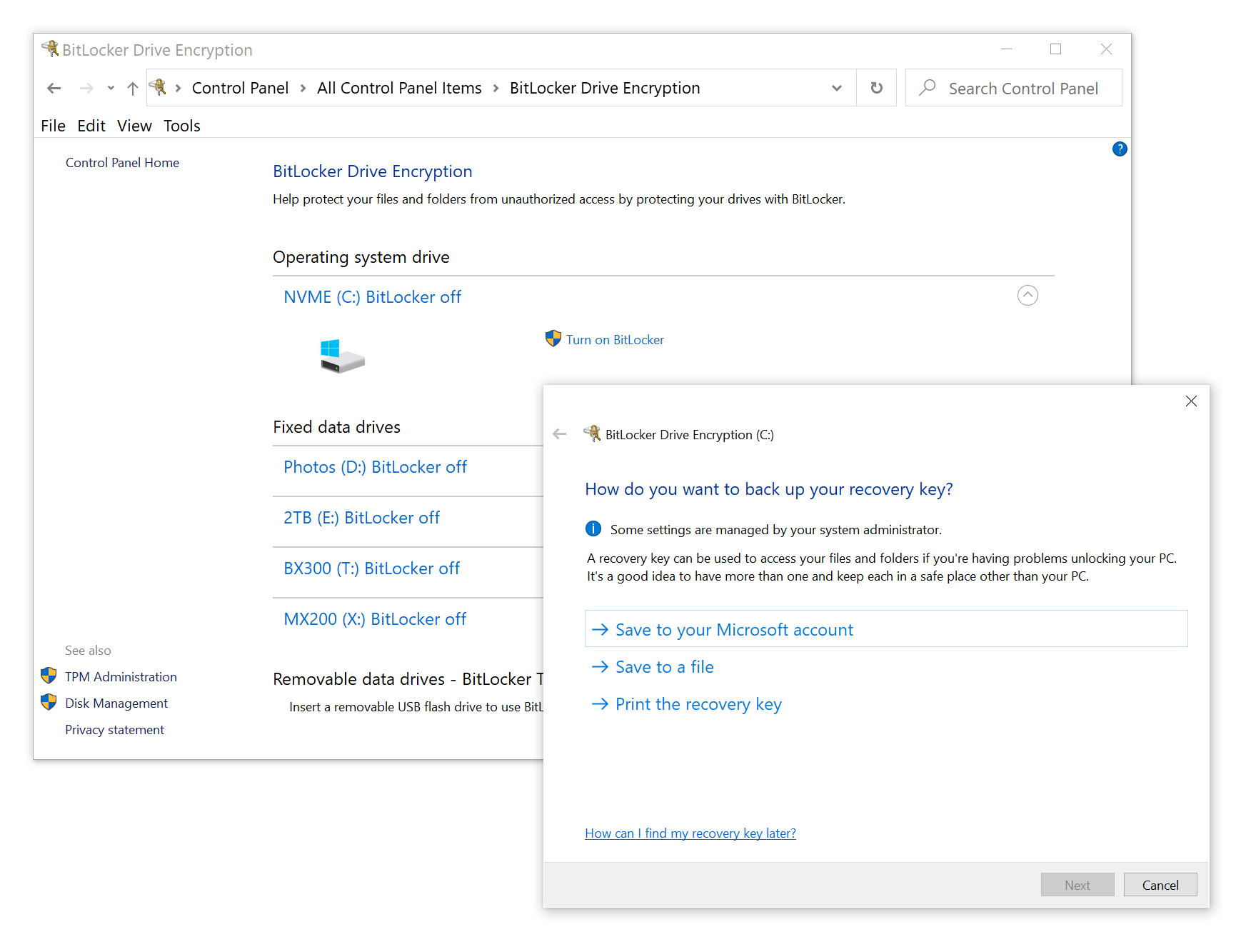

- Enabling bitlocker how to#
- Enabling bitlocker install#
- Enabling bitlocker windows 8#
- Enabling bitlocker windows 7#
Reg.exe add HKLM\SOFTWARE\Policies\Microsoft\FVE /v OSEncryptionType /t REG_DWORD /d 1 /fĪt the last part of the Task Sequence create a group called Enable BitLocker Reg.exe add HKLM\SOFTWARE\Policies\Microsoft\FVE /v EncryptionMethodWithXtsRdv /t REG_DWORD /d 7 /f

Reg.exe add HKLM\SOFTWARE\Policies\Microsoft\FVE /v EncryptionMethodWithXtsFdv /t REG_DWORD /d 7 /f Reg.exe add HKLM\SOFTWARE\Policies\Microsoft\FVE /v EncryptionMethodWithXtsOs /t REG_DWORD /d 7 /f Reg.exe add HKLM\SOFTWARE\Policies\Microsoft\FVE /v EncryptionMethod /t REG_DWORD /d 7 /f
Enabling bitlocker install#
Set Windows 10 Registry SettingsĪfter post OS install create a group called BitLocker Registry Settings, we can’t wait until the GPO pushes down during the OSD so we have to get the following registries into Windows 10.
Enabling bitlocker how to#
The steps below will show how to set it up in the task sequence. When the Control Panel application appears, click to open it.Scenario: A client requires their Windows 10 drives C: and D: Encryption Method is XTS-AES 256, fully encrypted and BitLocker Recovery key stored in Active Directory. To begin searching within the Start Menu, simply just start typing “control panel” (it is NOT necessary to click inside a search bar).
Enabling bitlocker windows 8#
The key will automatically be sent to an NAU database.Įnabling BitLocker with a TPM Chip with Windows 8 You may choose any of the other options as well to back up your recovery key. When you get to the window asking “How do you want to store your recovery key?”, click on the “Save the recovery key to a USB flash drive” option.
Enabling bitlocker windows 7#
If the computer is shut down, the encryption process will pause until the computer is turned on again.Įnabling BitLocker with a USB Key with Windows 7 The computer may be used as normal during this time. Note: The encryption will likely take several hours to complete. Once you have decided what to do with your recovery key, click “Next”.Ĭlick “Start Encrypting” to begin the encryption process. Note: If you choose to create a backup recovery key, do NOT store it anywhere near the computer it unlocks. The key will automatically be sent to an NAU database. When you get to the window asking “How do you want to store your recovery key?”, you may select any of the given options to store and save your recovery key. Open the Start Menu (usually located in the bottom-left hand corner).Ĭlick on “Control Panel” from the Start Menu.įrom the Control Panel menu, click on “System and Security”.įrom the System and Security menu, click on “BitLocker Drive Encryption”. Log onto Windows using an NAU domain account that has Administrator privileges. Allow the machine to boot Windows normally. (Note: The internal HDD in this example is listed as “WDC WD5000AAKX-75U6AAC”, and can be listed as something very different in your machine.) If it is not, select the item in the list and use the arrow buttons beside the list to move the selected item up or down. In the Boot Sequence list, ensure that the “internal HDD” is above “USB Storage Device”. (Note: The space bar on your keyboard will also open the tree.) Then, navigate to “Boot Sequence”. Open the “General” tree by clicking the “+” next to it. Ensure only the “TPM Security” and “TPM ACPI Support” check boxes are checked. If it is not, select the radio button next to “Activate”. If the radio button next to “Activate” is already selected, and the check boxes next to “TPM Security” and “TPM ACPI Support” are already checked, move to Step 9. Then, repeat Step 2 to navigate back to “Security > TPM Security”. If it is not, check the check box next to “TPM Security”. If the check box next to “TPM Security” is already checked, skip to Step 6. (Note: The space bar on your keyboard will also open the tree.) Then, navigate to “TPM Security”. Open the “Security” tree by clicking the “+” next to it. Your computer’s BIOS may look very different, but the concepts and locations should all be the same. Note: The following screen shots show the BIOS of a Dell Optiplex 7020 desktop. If this is the case, use the arrow keys, space bar, and enter key on your keyboard to navigate, open, and select. Note: Some versions of BIOS do not allow you to navigate with a mouse or touchpad. This will bring you to the Dell BIOS menu. When the Dell logo appears, tap the “F2” key on your keyboard repeatedly until the message “Entering Setup” appears.


 0 kommentar(er)
0 kommentar(er)
